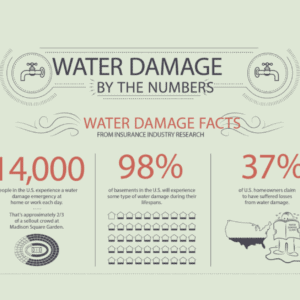The best way to keep tenants happy and costs down as a property manager is to have a flood damage prevention plan in place for your properties. You cannot be at all of your managed properties all of the time, so how do you prevent little things from turning into big costly flood damage restoration projects?
Water Damage Prevention
If you are not recruiting the people that spend the most time at the property – tenants and regular maintenance crews – to keep an eye out, you are not optimizing your water damage prevention plan. Include them in your prevention plan by implementing the following:
Tenant Prevention Education
Little leaks turn into big problems – stress this to your tenants and train them to report water damage risks if they see it.

Things to look for include:
- standing water
- musty smells
- running water sounds – even when all water sources are shut off
Tenant education should cover unreported leaks and flooding risks:
-
- Mold & Mildew:
Mold spores are hazardous to the health of your tenants as exposure to mold and mildew can often trigger asthma episodes, allergies, and irritation to the eyes and the respiratory system.
-
- Damage to Foundation:
Clogged gutters and damaged downspouts can feed stormwater towards the footing of buildings or cause standing water to collect flooding walkways and parking lots/structures. This causes damage to building foundations compromising the integrity of the structure over time.
-
- Leaky Roof:
Water that builds up on roofs due to poor drainage can produce moss growth under roofing shingles which compromises the waterproofing and can lead to water infiltration. This can turn into a water damage nightmare if water finds its way into one of the units damaging property inside the home.
-
- Dangerous Conditions Inside Walls:
Leaky pipes that run inside of walls easily go unnoticed because they are not visible, but tenants can hear if something is not right. Pipes inside walls that have a leak and are neglected can cause damage to drywall, wood rot, and damage to electrical housed inside of walls. All of these situations can be dangerous as they relate directly to structure, fire danger, and tenant health.
Regular Maintenance & Prevention Inspection
Maintenance crews should be able to spot problem areas and come to you with a plan of action. Keeping gutters clean and pipes maintained will prevent flooding in areas with bad drainage and burst pipes.
Suggested areas for regular inspection:
-
-
- condensation on windows
- ceilings and walls to check for water stains
- areas including walls and flooring around water heaters and HVAC units
-
All of these areas can easily be inspected without interfering with tenant privacy or when scheduled maintenance on a unit is being performed. This should not be considered a full list of problem areas.
Why Everyone Should Care About Water Damage Prevention
When small leaks, gutters and drains, and irrigation systems are neglected, larger more expensive problems can be expected on the horizon. Not only do small leaks lead to major water damage, but it can be hazardous to the health of your tenants and building.
Business as Usual After Water Damage
Because we cannot plan for everything, a business continuity plan should be considered as part of your water damage prevention plan.
What to Consider:
-
-
- Insurance
-
Does your insurance policy cover all types of water damage that can occur?
-
-
- Vendors
-
Build a relationship with a highly rated, local water damage restoration company.
Certified Restoration
Property managers in the San Diego, CA, can expect that professional, prompt water damage restoration services are available from Certified Restoration. We will begin work at your property promptly – our policy is to arrive at any property in San Diego within an hour to stop the cause of your water damage and start repairing the damage. Learn more about our property management program today!



